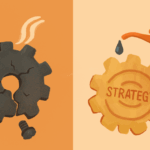“A working machine must not play the piano.”—Rossum’s Universal Robots (RUR), Karl Capek, 1920
Artificial intelligence (AI) has a growing role in higher education marketing and communications. The first step toward harnessing the power of AI for recruiting and enrolling students was taken long ago: personalization. For years, admissions teams have used personalized emails; it’s quaint to think of anything else. Machine learning is just the most recent advancement.
At this moment, admissions teams are using student data, purchased from a third party or collected from current student activity, to build machine-learning models that help them further personalize those messages. The teams then send the messages to people they know will have a much higher chance of opening and reading those messages.
Now, the weight of the step after personalization is pressing down on us: AI-generated text and images that machine-learning models know will resonate with the person receiving the message. We can see the shadow of this in the shape of online AI text-prompt-to-visual art generators.
A quick search will turn up several different AI text-to-art tools, each with its own tiers of access. Many include free plans that limit users to a few prompts (the term for information provided to the AI). Free access runs out quickly because these tools require considerable computing power to operate; computing power is managed by a company; and capitalism requires that companies need to make money. Subscribers pay for access to the AI’s processing centers.
Most of the platforms work the same. The user interface asks a human for a text description of what the human would like to see realized by the AI. The AI goes to work, running keywords through machine learning models, pulling images and colors from anywhere it can access, applying the effects requested or inspired by the prompt and, then, offering a selection of images. From those images, the user decides the next step, anything from editing the prompt or totally starting over to asking for variations on a suggested image the user feels is in line with the idea they’re trying to express. Each variation along the way can have a bit more detail added to it with increased output from the AI processors.
Working on an image feels the same as creating any written, musical or visual art piece. The creator or team experiences a rush by pursuing an idea, turning away from something that’s not working and finding surprising beauty.
Plus, it’s fun.
Let’s explore a few options for small teams to inspire conversation about AI in marketing and highlight the currently available AI tools.
Submission Calls
“The product of an engineer is technically at a higher pitch of perfection than a product of Nature.”—RUR
The first option is the least amount of work for comms teams: soliciting AI art generated by the community.
A call for submissions could result in some very compelling imagery that would then be shared on social media platforms: “Use AI to generate an image showing how you feel about your time here,” or something along those lines. As with any call for submissions, a prize or some kind of contest framework (“we’ll choose the top five to feature on social media”) will help ensure you have submitted content.
A drawback of this approach is that someone will make something, second guess themselves and not send it in. Although this user-generated approach is straightforward and means less work for comms, it also has the least value.


High Risk, High Reward
Another option for gathering and sharing this amazing content comes from a hugely collaborative and a bit more expensive method. However, it has great promise. The first obstacle is securing funding to subscribe to an AI generation platform at a tier that does not limit how many images the account can create, vary, upscale and download in good quality. Before closing this page and dismissing anything with a cost attached to it, let’s run through what this hypothetical situation could look like and how it has great potential for a significant return on investment.
With an unlimited account to an AI generator, the comms team can fashion a message to be shared regularly throughout the academic year: we’re using student-submitted prompts to generate AI artwork about this school, submit a prompt (through a source). Once that prompt is in hand the whole team gets to work. Book a time with designers, writers and others on your team who communicate about the school to prospective students, sit in the same room and run through variations and upscaling together. Designate someone to be the ultimate decider of when the image is “done” and then share it, with the prompt, proudly and widely on social media and a gallery on your website.
The benefit of having a whole team collaborate on the generation of several AI images is, at the very least, that it is a fun team-building exercise. It also ensures that the resulting image is aligned with brand guidelines and other messaging that’s being shared with students. Twelve images created in this way provide a year’s worth of content—“AI image of the Month” or some such.
Here is an added bonus: provide these images to your admissions team. The images could be added to the digital screens that prospective students see while waiting for their campus tours. Fascinating, beautiful and—unless everyone reading this puts this into effect—a differentiator.


Low Risk, More Work
As promised, here are a few other low-cost ways to incorporate AI-generated content.
- Solicit prompts in the same way, and then the marcomms department social team can hop between free tiers of AI art generators to create fewer images. There will be some style differences between the images, but there will be significantly lower costs.
- Arrange “AI Sessions” in student spaces where a marketing and comms team representative can sit with students for a few minutes to input prompts, letting the student shape how the image is upscaled and finished. After an hour, there’s a nice collection of cool content to share, and the event itself is a content source.
- Secure the AI platform access tier at a medium level, and then have all the work done in-house. Dedicated time from staff limited by the subscription access level means teams are aware there’s a limit to how many variables they can consider for a prompt before making a final choice. Deadlines help productivity.
- Writers and admissions team members come up with the prompts, designers take a couple of dedicated hours to iterate, and the images used are then shared on social media, or even included in web and print materials to illustrate brand messages. This cuts out student voices entirely but does involve more of that crucial aspect of successful marketing: strategy.


Takeaways
One quick note of interest, the words and ideas from each school seem to ask the AI to draw upon similar colors. Could this be a way to identify a lack of differentiation in the messages sent to students? That’s work for broader research.
Beautiful images, collaborative creative processes and the inclusion of student voices into the design workflow are all great benefits of exploring how teams can start using AI-generated artwork today. However, there is a much more basic marketing tool these efforts will provide.
Each prompt from a current or prospective student includes the keywords and ideas they feel exemplify, or even criticize, the school in which they’re interested or currently attend. Marcomm teams are sustained and informed by those keywords. With a spreadsheet full of what students actually think about the place, marketers can get to work amplifying those messages, addressing common concerns and knowing which brand ideas need a bit of reinforcement.
Those keywords can also be fed into machine learning models that will guide personalized, AI-generated viewbooks—but that’s a story for another day.








